
In this day and age, it can be difficult to choose anything. There are too many options out there. This is certainly the case with bathroom fans.
Every manufacturer has 10 different models that look almost identical but have different model names. It is very easy to get decision paralysis when presented with so many options. Most of the parameters that they quote do not make any difference for the average household.
I will do my best to make this guide as simple as possible and try to distill it down to only what is really important.
The steps are designed to make it very easy to choose the right bathroom exhaust fan. At the same time, I have tried to include all the important information so that you will get the best fan for your needs.
Maybe your bathroom fan does not need to be replaced. Before you continue, check out the 7 reasons why the bathroom fan is not removing steam.
Before I begin I will explain how bathroom fans are rated. This way you are not confused by CFMs and Sones. If you already know the basics feel free to skip over.
How are Bathroom Exhaust Fans Rated

Bathroom fans are rated by two main categories: how much air they move (CFM) and how much noise they make (Sones). When comparing fans of similar size, a fan with higher CFM and lower Sones is better.
CFM rating
The CFM rating is the most important value to look for when choosing a new bathroom fan or any fan for that matter. It needs to be adequate for your needs. If you install a tiny 50 CFM fan in a massive 200 square feet bathroom it will be of little use in keeping the room’s moisture level down and room smelling fresh.
Cubic Feet Per Minute(CFM) is used to measure the amount of air a fan moves in one minute. The bigger the number the more airflow the fan will provide.
Think of it this way: let’s say you have an 8 ft high 50 sq. ft bathroom. That is 400 Cubic feet. (8ft x 50ft =400cu. ft.) A fan that replaces the air once an hour in our hypothetical bathroom is rated at 6.66 CFM (400cu. ft. / 60 min). However, once an hour is not nearly enough, this example was presented only to clarify the concept of how bathroom fans are rated.
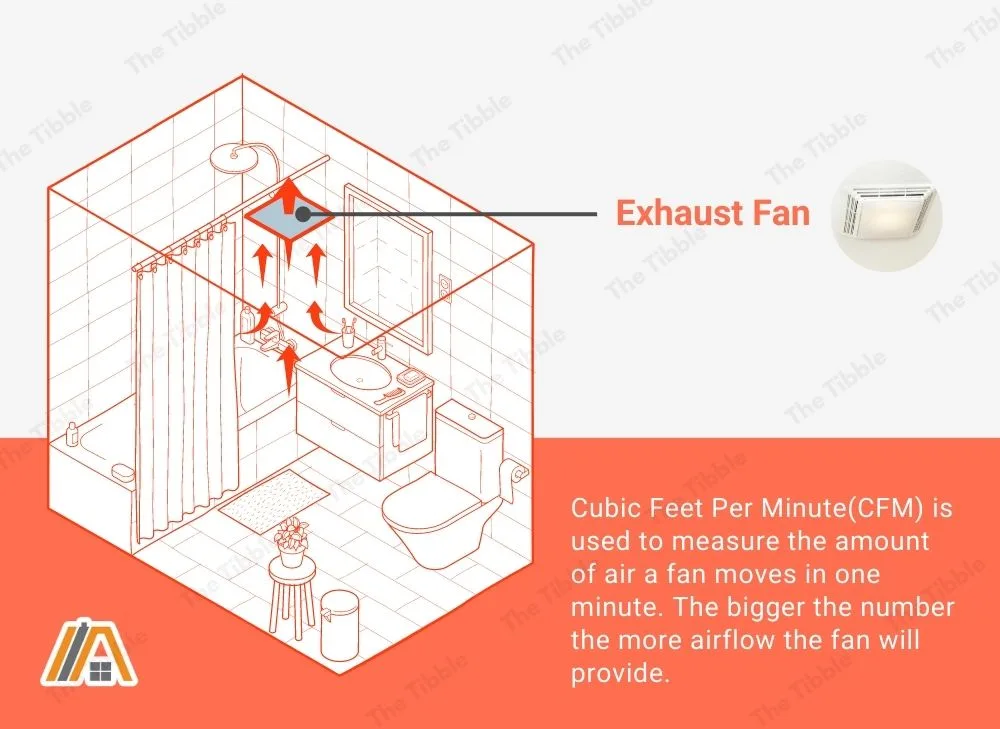
Sone Rating
Let’s start by saying that if you are a person who is sensitive to background noises, then understanding the sone rating can really be beneficial. Furthermore, sone rating is used for countless other home appliances to measure how noisy they are.
Sone rating is used to measure how much sound a fan makes when in operation. The sone rating is linear, meaning 2 sones is about twice as loud as 1. The rating is based on how it is sensed by the average listener.
Here I have a list of 8 super quiet bathroom fans. They are truly the quietest on the market today and I will keep this list updated.
If you are picking out a new bathroom fan then consider choosing one with the lowest sone rating that your budget allows. However, keep in mind that the CFM still needs to be adequate for the room size.
There are bathroom fans with a sone rating of 0.3. They are close to silent and well worth the premium.
Let’s look at the sones levels a little closer to give you a better idea of how loud or quiet they really are.
Sone Levels
- 0,3-1 Sones: Most likely you are not gonna even notice that the fan is turned on. You will have to pay a premium for a fan with that low a sone rating, and they tend to be very low CFM as well.
- 1-2 Sones: This can be compared to the sound of rustling leaves. This won’t bother most people who are not hypersensitive to background noises.
- 2-2.5 Sones: When looking at fans that are 2 sones and up you will start to hear when it is turned on, you can compare it to a working refrigerator. However, it should not be noticeable in the next roof if you close the door. Furthermore, some people like the assurance that their fan is actually on.
- 2.5-3 Sones: This will be 3 times as loud as a 1 sone fan. Can be compared to a dishwasher.
- 3-4 Sones: Sound level comparable to watching TV with normal volume. This is too loud for a bathroom fan and should be avoided if possible. It will be heard in the next room even when the bathroom door is closed.
How do Sones Compare to Decibels?
This table will help you compare sones to decibels. Note that the values are only approximate since it is not possible to directly calculate them.
You can find a Sone to Decibel calculator here
| Sone | dBA |
| 0.3 | 23 |
| 0.5 | 25.5 |
| 0.7 | 28.5 |
| 0.9 | 30 |
| 1.2 | 32 |
| 1.4 | 33 |
| 1.6 | 34 |
| 1.8 | 35 |
| 2 | 37.5 |
| 2.2 | 38 |
| 2.4 | 39 |
| 2.6 | 39.5 |
| 3 | 40 |
| 3.9 | 44.5 |
Find The Optimal CFM For The Bathroom Fan
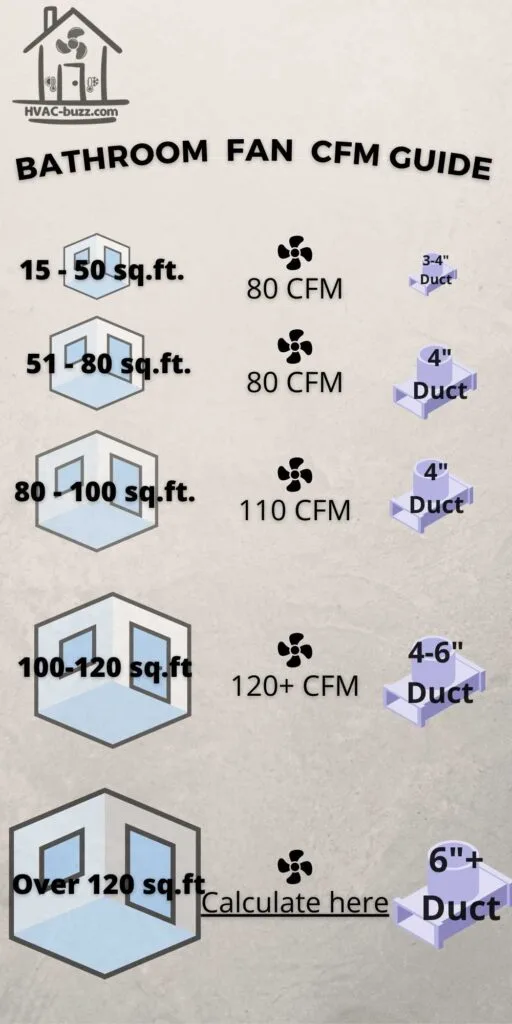
Cubic feet per minute (CFM) is the amout ouf air the bathroom fan moves per minute in cubic feet.
If you wish to learn more about CFM you can visit my previous article on how are bathroom fans rated.
To keep things simple I have created a calculator where you can fill in the dimensions of your bathroom and it will automatically calculate the optimal CFM.
Bathroom Fan CFM Calculator
Fill in your bathroom dimensions and the calculator does the rest.
I have based the calculator on 8 air changes per hour, as recommended by the Home Ventilation Institute.
You can always go over the calculated CFM. This will only ensure that the moisture is cleared out quicker.
My recommendations for 50 CFM bathroom exhaust fans
My recommendations for 100–110 CFM bathroom fans
However, It is not recommended to install a bath fan with a lower CFM. A bathroom fan that is too weak will not clear out the moisture fast enough and it will have time to spread around the house.
Choose an Optimal Location
As long as the bathroom fan is inside the bathroom, it will work.
But if you would like to make it work as efficiently as possible it is best to place it close to the shower, but not directly in the shower as this can cause cold air to blow on to you while showering.
I have an entire article dedicated to where to place the bathroom fan, if interested go take a look.
If you want to keep it simple, just install it according to the illustration below.
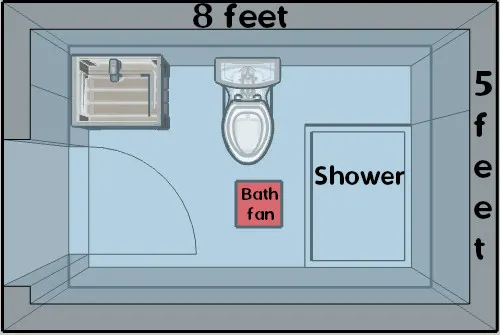
Choose a Type Of Bathroom Fan
If you are going to replace a existing bathroom fan you can skip this step.
If installing a new fan you have a choice between installing it on the wall or the ceiling.
Related Article: Are Bathroom Fans Necessary
Since hot steam from the shower moves up, installing the bathroom fan on the ceiling is the most efficient option.
Ceiling Mounted Bathroom Fan
If possible bathroom fans should be installed on the ceiling.
Going through the ceiling will always involve some ducting. Depending on how good the attic access is installing ducting might be very difficult. (Think 3 ft of blown insulation and no walkway)
Ceiling-mounted bathroom fans are by far the most popular. This means that the selection is going to be much better.
Wall Mounted Bathroom Fan
In case you don’t have access to the attic there is another option. Mount it on an exterior wall. This will involve no ducting and can be done with a ladder and a jigsaw.

Keep in mind that the selection of through-wall bathroom fans is very limited in North America. For some reason, they are more common in Europe.
Actually, the only one I found that is quiet enough to be used in a residential bathroom is the Panasonic FV-08WQ1. (amazon link)
As far as I know, this is the quietest through–wall bathroom fan on the North American market. It is rated at a whisper-quiet 0.3 Sones. I guess that’s where its name “Whisperwall” comes from 🙂
While It is possible to install most regular bathroom fans on a wall. It is much easier to install a bathroom fan that is designed for a wall.
This will make installation much easier. Most of them have telescopic collars that cover the inside of the wall. (see picture above)
Another advantage is that the damper is designed for vertical operation and will not leak, nor cause any noise when windy.
Here is an helpful guide if you would like to learn more about ventilation dampers.
Inline Bathroom Fan
The third option is an Inline fan.
An inline fan is great if you have multiple bathrooms and would like to have one fan serve both of them.
In a previous article, I have composed a kit of all parts for an inline fan system so I will not list them here.
Remote inline fans are often quieter since the fan is further away from the bathroom.
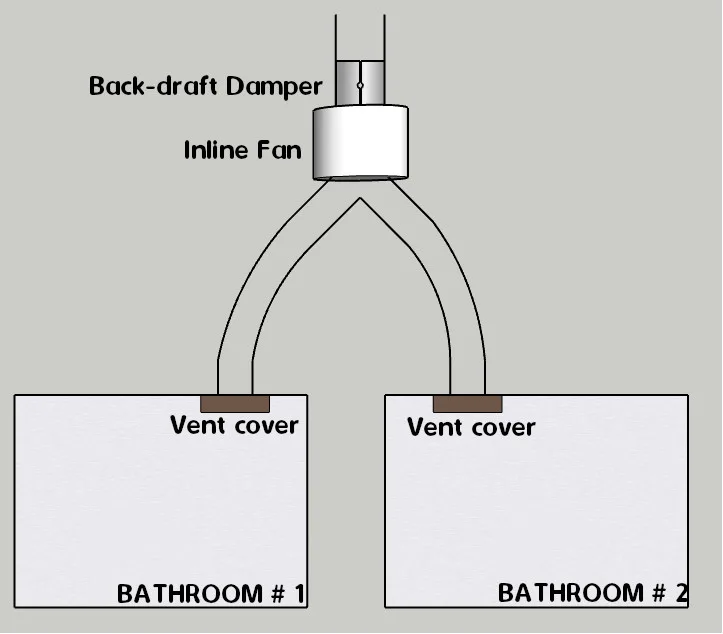
Measure Cutout Dimensions
Ignore this step for inline fan or during new installation.
By now you have decided on how many CFM you need and what type of bathroom fan you want to install.
Next comes the cutout dimension. This is the actual hole in the ceiling/wall.
It’s best to remove the cover from your old bathroom fan and measure the hole in the ceiling/wall to get the most accurate measurements.
When replacing an existing bathroom fan it is wise to choose a fan with the same or slightly larger cutout dimension. This will eliminate the need for any drywall/tiling work and make the installation more plug and play.
Following this simple advice will save you hours of work
Here is a table of common cutout dimensions and corresponding bathroom fans.
Find Out The Duct Size
Find out by removing the old fan what dimension your duct is, this will make installing the new fan much easier.
While it is possible to buy adapters to change from say example 6″ to 4″ duct, it is not recommended.
If you have a 4″ duct in your bathroom, do not buy a fan with a 6″ duct connection.
By downsizing the duct you will significantly increase the backpressure and the fan will have to work much harder. This will make the fan less efficient and much much louder than specified.
I once installed a range hood duct that was 1 size too small for the particular range hood. I thought I will simply fit an adapter to make it fit. This was not a good idea, the fan was so loud, that in the end I had to replace the duct with the correct size and spent way longer on it than I should have.
Even when a 6″ fan comes with a 4″ adapter it is not a good idea, since the fan is ideally designed for a 6″ duct and will be louder than a comparable 4″ fan.
Consider The Noise Level

In North America bathroom fan noise level is measured in Sones.
Learn more about sones here.
Decibels are used in other parts of the world. You can find a Sone to Decibel Calculator Here.
While most people prefer their bathroom fan to be as quiet as possible, others like to have a loud bathroom fan to conceal embarrassing bathroom noises 🙂
Anything under 0.5 Sones will be very quiet, and will be barely noticeable.
Here you can find the 9 quietest bathroom fans on the market today. You should be able to find a suitable fan from this list if you appreciate a quiet bathroom fan.
How The Bathroom Fan Is Operated
There are a number of different ways a bathroom fan can be turned on and off. Ranging from a simple physical switch to a smart home controller that can be set up from your computer.
This is not actually something that you must consider when buying the bathroom fan, however it might be helpful to think ahead and upgrade the switch as well. Especially if you currently have a manual on/off switch.
Physical On/Off switch
This is the most basic way to operate the bathroom fan. I would not recommend this.
It is very difficult to keep the fan running for long enough this way. Especially when there are small children in the house.
Most people who have a regular switch installed will turn the fan off immediately after the shower together with the light. This can lead to moisture damage.
A bathroom fan should be running for at least 30 minutes after the shower has been turned off.
I recommend keeping it running even longer during wintertime to make sure all of the moisture is exhausted out of the house.
Here is a graph from my smart home humidity sensor.
You can see from the graph that it takes close to an hour for the humidity level to drop back to normal levels.
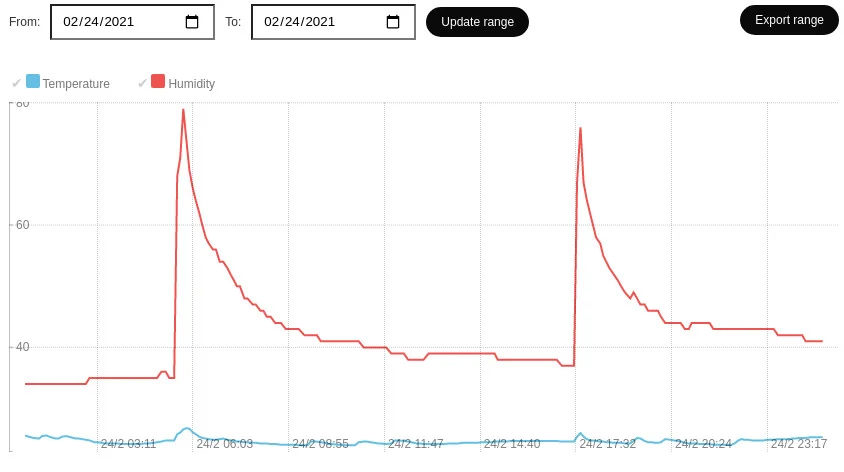
Timer Switch
A timer switch is a very simple and reliable way to control a bathroom fan.
I have written a detailed article about bathroom fan timer switches, so I will not discuss them here any further.
Humidity Sensor/Switch
In my opinion, humidity sensor/switch is the best way to control a bathroom fan.
I like it since after installing it you can totally forget about turning the fan on. It will be handled automatically and only when needed.
Try to stay away from the cheapest options since the humidity sensors on them won’t last very long. I have gone through a couple before I learned my lesson and bought a quality humidity switch. (amazon link).
This switch, once set up will function completely automatically, with the option of turning the fan on manually if needed. But this should not be necessary since it comes with a PIR motion sensor that turns on the fan when it detects movement.
The duration of ventilation after movement is detected, and the fan activation humidity level are both easily programmable by the user.
Note: the humidity level should be set twice a year. During wintertime the indoor air will be much dryer so the humidity level should be lowered. Vice versa during summertime.
Continuous ventilation
If your fan is always running, then most likely you have continuous ventilation. This means that the fan is controlled by a external HVAC ventilation controller.
Most likely the fan will not be a typical wall or ceiling mounted fan but a remote inline fan.
Read more on continuous ventilation here.
Conclusion

The most important things are correct airflow and quiet operation.
By measuring the duct size and cutout hole you can greatly reduce the time/cost required to install the bathroom fan. A humidity switch is the best way to control the bathroom fan.
Hope you found this article helpful. Please vote yes or now below to let me know, so I can improve the future articles.
Thank you! 🙂

